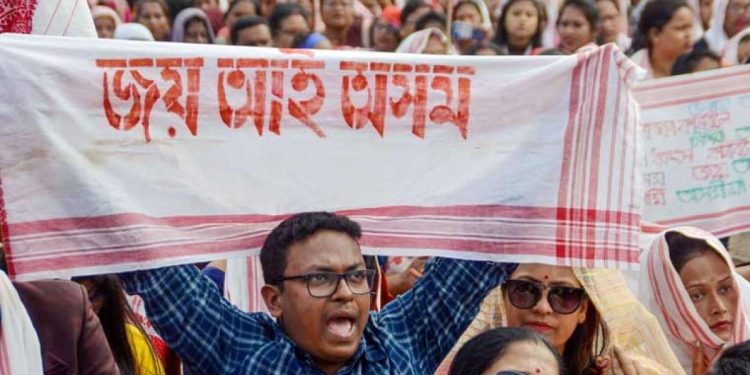Assam and Tripura, two neighboring states in Northeast India, share many similarities in history, culture, and language, while also exhibiting significant differences. In recent times, the crisis facing indigenous languages in Assam has frequently brought Tripura’s example into the spotlight. The endangerment of the language and culture of the indigenous Tripuri community in Tripura raises a critical question about Assam’s linguistic future: Is Assam truly heading down the same path as Tripura?
Linguistic Situation in Tripura
Tripura has a rich history of a royal tradition led by the indigenous Tripuri community. However, today, the Tripuris have become a minority in their own state. According to the 2011 Census, 63.48% of Tripura’s population speaks Bengali, while only 25.90% speak Kokborok, the mother tongue of the Tripuri people. This demographic reality starkly contrasts with the pre-independence era. In 1941, approximately 53% of Tripura’s population spoke tribal languages, including Kokborok. However, between 1941 and 1951, this figure plummeted to 37%. Currently, the proportion of speakers of indigenous languages has fallen below 30%.
The primary reason for this shift is identified as large-scale migration from erstwhile East Pakistan (now Bangladesh). This migration has profoundly impacted Tripura’s linguistic and cultural identity, with the dominance of Bengali speakers endangering the Tripuri language and culture. As a result, the indigenous Tripuri community is compelled to struggle for its survival.
The Threat to Indigenous Languages in Assam
A similar concern is emerging in Assam. Although Assamese is the state’s primary official language, the 2011 Census reveals that only 48.38% of Assam’s population claims Assamese as their mother tongue. In 1991, this figure stood at 57.81%, but by 2001, it had declined to 48.80%—a drop of approximately 9% in a single decade.
In contrast, the proportion of Bengali speakers in Assam has been steadily rising. In 1991, Bengali speakers accounted for 21.67% of the population, which increased to 27.54% in 2001 and further to 29.91% in 2011. Alongside Assamese, other indigenous tribal languages such as Bodo, Rabha, Mising, Tiwa, and Karbi have also seen a decline in their share of speakers. For instance, the percentage of Bodo speakers decreased from 4.86% in 2001 to 4.53% in 2011.
The Crisis of Assamese’s Role as a Link Language
In Assam, the Assamese language has historically served not only as a mother tongue but also as a crucial link language facilitating communication among diverse communities. However, this role is now under threat. In districts like Dima Hasao, Karbi Anglong, and West Karbi Anglong, the use of Assamese is steadily declining. These regions are witnessing a growing prominence of Hindi and English, which is undermining Assamese’s role as a link language. In Dima Hasao, Hindi has already emerged as the dominant language, while in the Karbi Anglong districts, Hindi and English are gaining ground.
Concurrently, there are signs of waning interest in Assamese among Assam’s tribal communities. What could be the reasons behind this trend? Have the behavior or socio-political dynamics of the linguistic Assamese community contributed to dissatisfaction among tribal groups? These questions demand introspection and resolution.
The East Bengal-Origin Muslim Community and the Assamese Language
The linguistic identity of the East Bengal-origin Muslim community in the Brahmaputra Valley is another critical aspect of Assam’s linguistic landscape. Historically, this community has declared Assamese as their mother tongue in censuses, contributing to maintaining Assamese’s majority status. However, recently, some minority leaders have suggested that this community should declare Bengali as their mother tongue instead of Assamese. While this view is not universally supported, such a shift could significantly impact the demographic prevalence of the Assamese language.
Concerns for the Future
The 2021 Census was not conducted in India, but the next census will likely take place by 2026. In this context, there is a strong possibility that the proportion of speakers of Assamese and other indigenous languages will further decline, while the number of Bengali and Hindi speakers may continue to rise. This trend poses a serious challenge to the linguistic and cultural heritage of Assam’s indigenous communities.
Tripura’s experience serves as a warning for Assam. Timely measures are essential to preserve indigenous languages and cultures. Revitalizing Assamese’s role as a link language and implementing policies to protect tribal languages are critical steps that need to be taken.
A comparison of Assam’s linguistic situation with that of Tripura underscores the urgent need for proactive measures to preserve language and culture. Safeguarding Assamese and other indigenous languages from this crisis requires social awareness, robust educational policies, and a renewed emphasis on cultural identity. Without such efforts, Tripura’s cautionary example could become a reality for Assam, marking a tragic outcome for the greater Assamese community.





